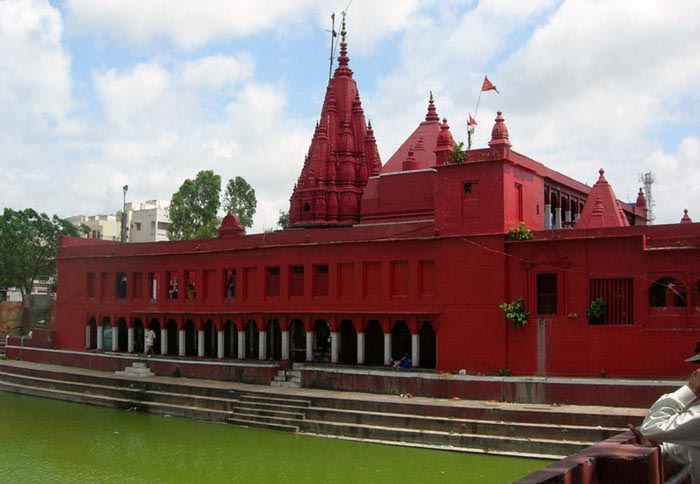Durga Temple

Information of Durga Temple, Varanasi, Uttar Pradesh
Durga Temple is regarded as one of the most significant temples for Hindu. It is also known as Monkey Temple since there is considerable number of monkeys exist on the site. As the name suggest, Durga Temple is dedicated to goddess Durga. It is located in a quadrilateral reservoir named Durga Kund, at the panel of Ganga River in Varanasi. The santity of the temple is well known and praised by the devotees from all religions.
Durga Temple Religious Significance
Goddess Durga has high significance in Hindu religion. She is believed to be the symbol of power and manifestation of lord Parvati, the wife of lord Shiv. Basically, lord Durga represents the female component of power who can bring harmony. It is prominent that Bengalis are regarded as the most ardent believers of lord Durga. The key festival of Durga Temple is Durga Puja which occurs in the month of October. This festival begins with Mahalaya, i.e. the first phase of waxing moon and ends with Dashami. Furthermore, Navratri is also celebrated in Durga Temple.
There is a religious belief that lord Durga resided in Durga Temple for many eras. She defended Varanasi as one of the fierce protectors of the holy place. Furthermore, it is also believed that the statue of lord Durga in the temple was not created by human, rather it was a self-manifested sculpture.
Durga Temple Mythology & History
Hindu mythology states that once upon a time, the king of Ayodhya, Dhriva had two wives namely Manorama and Lilavathi. They both had son named Sudarsana and Satrijith respectively. One day, king Dhriva went on a hunt and executed by a lion and after his death, the minister decided to make Sudarsana the next king of Ayodhya. However, the second wife of king Dhriva, i.e. Lilavathi argued such decision and consequently her father plotted a plan in order to kill the son of Manorama, i.e. Sudarsana. Knowing that they both got scared and left the kingdom. Manorama went to a saint named Bharadwaja for protecting her child. The saint educated him to worship goddess Durga. As a consequence, Sudarsana stared to worship lord Durga and after many years the goddess herself appears before him. Lord Durga was so pleased with the devotion of Sudarsana and granted him a divine bow and arrow. Afterwards, the daughter of the king Subahu named Sasikala fallen love with Sudarsana. In a dream, lord Durga also told Sasikala to marry Sudarsana. However, while marrying Sudarsana, Sasikala and her father was threatened by the grandfather of Satrijith for selecting Satrijith as her husband. Still, Sasikala denied to do so as she had trust on lord Durga to protect them. As a consequence, a serious battle started between Sudarsana and Satrijit. On that time, goddess Durga arrived in the battlefield and killed both Satrijit as well as his grandfather. Thus, their army also got frightened and left the battlefield. Sudarsana become victorious and hence king Subahu also become believer of goddess Durga. He started worshiping lord Durga profligately and hence pleased the lord. Goddess Durga asked him to obtain any wish and thus, king Subahu requested her to exist in Kashi and protect the kingdom. Thus, goddess Durga accepted the request and resided on the place where the present Durga Temple was created. Thus the strong belief and the religious importance makes this temple revered, where thousands of devotees come to offer prayers and seek blessing from the deity that resides here.
Durga Temple Architectural Significance
Durga Temple was created in 18th century by a Bengali queen. The architecture of the temple is based on North Indian style. The temple possesses multi-tiered spikes and is marked with red colour. The reservoir of the temple was primarily linked directly with river Ganga and hence, the water was automatically refilled. However, in later phase, the channel was closed and hence the water supply. Still, the reservoir is the source of beauty of the temple which has stone made stairs along with watch pillars in every corner. Thus one can see splendid architectural phenomenon which is highly appreciated.
- Andhra Pradesh Temples
- Assam Temples
- Bihar Temples
- New Delhi Temples
- Goa Temples
- Gujarat Temples
- Jammu and Kashmir Temples
- Karnataka Temples
- Kerala Temples
- Madhya Pradesh Temples
- Maharashtra Temples
- Odisha Temples
- Punjab Temples
- Rajasthan Temples
- Sikkim Temples
- Tamil Nadu Temples
- Telangana Temples
- Uttar Pradesh Temples
- Uttarakhand Temples
- West Bengal Temples